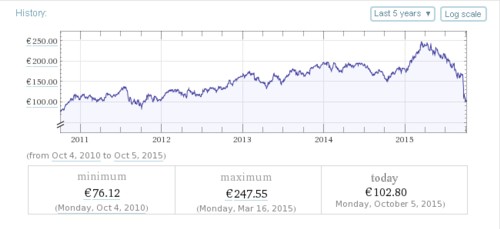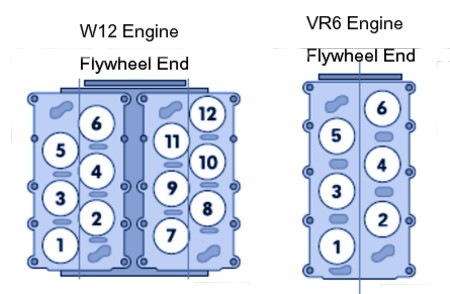SHORT TERM FUEL TRIM ISSUES
Modern day OBD-II systems can be described as high-end electronic systems that "sort of" took the automotive industry by surprise. As such , there are so many motor mechanics that have not made the transition from technologies prevalent in older model cars to the technologies pervasive in newer model cars yet, and understandably some never will. Several of these motor mechanics don't even own a scan tool and even fewer of them are able to interpret the DTCs and the results of a diagnostic scan. With the result, that many VW owners took it upon themselves to become ODB-II savvy and even do their own automobile repairs. Many of whom have invested in low end scan tools like VAG COM, Actron, Nextech Carmen, Foxwell, OBD Scan, Altar, etc, and others invested in high end scan tools like G-Scan, VCDS, Xtool, Launch, AutoHex, Autel and Auto Boss etc. Even though the VW service departments are equipt with the best diagnostic scan tools they tend to lack the technical personnel with the requisite expertise to understand them and effectively repair clients VW, Audi, SEAT and SKODA cars. Electronics has taken over the modern day car and being knowledgeable about electronics is key however not every car owner is therefore not equipt to to analyse the diagnostic printout. As an example, lets take a look at the infamous VAG fuel trim problems list below. All of them very loudly shouts that the stoichiometric ratio is off. Generic Short Term Fuel Trim (STFT) DTCs range from P0170- P0175 which are generic government required codes and Long Term Fuel Trim (LTFT) range from P1123-P1130, P1139-P1139, P1151-P1152, P0166-P1167 and all are manufacturer specific.
SHORT TERM FUEL TRIM (STFT)
16554 - P0170 -
Fuel Trim, Bank1 Malfunction
16555 - P0171 -
Fuel Trim, Bank1 System too Lean
16556 - P0172 -
Fuel Trim, Bank1 System too Rich
16557 - P0173 -
Fuel Trim, Bank2 Malfunction
16558 - P0174 -
Fuel Trim, Bank2 System too Lean
16559 - P0175 -
Fuel Trim, Bank2 System too Rich
LONG TERM FUEL TRIM (LTFT)
17531 - P1123 - Long Term
Fuel Trim Add.Air, Bank1 System too Rich
17532 - P1124 - Long Term
Fuel Trim Add.Air, Bank1 System too Lean
17533 - P1125 - Long Term
Fuel Trim Add.Air, Bank2 System too Rich
17534 - P1126 - Long Term
Fuel Trim Add.Air, Bank2 System too Lean
17535 - P1127 - Long Term
Fuel Trim mult, Bank1 System too Rich
17536 - P1128 - Long Term
Fuel Trim mult, Bank1 System too Lean
17537 - P1129 - Long Term
Fuel Trim mult, Bank2 System too Rich
17538 - P1130 - Long Term
Fuel Trim mult, Bank2 System too Lean
17544 - P1136 - Long Term
Fuel Trim Add.Fuel, Bank1 System too Lean
17545 - P1137 - Long Term
Fuel Trim Add.Fuel, Bank2 System too Lean
17547 - P1139 - Long Term
Fuel Trim Add.Fuel, Bank2 System too Rich
17559 - P1151 - Bank1, Long Term
Fuel Trim, Range 1 Leanness Lower Limit Exceeded
17560 - P1152 - Bank1, Long Term
Fuel Trim, Range 2 Leanness Lower Limit Exceeded
17573 - P1165 - Bank1, Long Term
Fuel Trim, Range 1 Rich Limit Exceeded
17574 - P1166 - Bank1, Long Term
Fuel Trim, Range 2 Rich Limit Exceeded
17582 - P1174 -
Fuel Trim, Bank 1 Different injection times
THE DEFINITION OF A BANK
Before we continue, it is important to get certain definitions right. In 8 cylinder (W8) engines and 12 cylinder (W12) engines, 4 or 6 cylinders are staggered aligned at a V-angle, 72 degrees in relation each other, thereby making the engine more compact. Each staggered row of either 4 or 6 cylider has its own head, which is called a "Bank", hence Bank 1 and Bank 2. On the other hand VR6 engines cylinders are also staggered but has a single cylinder head, however the three left most side cylinders (odd numbers) are called "Bank 1" (passenger side left-hand drive) and the right most cylinders (even numbers) are called Bank 2. Four cylinder engines normally have 4 in-line cylinders but here as well, the odd cylinders are called Bank 1 and the even cylinders Bank 2 as can be seen in the "Chassic type: Skoda Fabia 1,2l/4V" below. But this configuration does apply to all 4 and 5 cylinders engines because in some engines all cylinders are referred to as bank 1. Looking at the above P-Codes P0170-P0175 it can clearly be seen that P0107 refers to Bank 1 and is common to both P0171 and P0172. And likewise P01703 refers to Bank 2 and is common to both P01704 and P0175. This information allows us to determine which cylinder is bank is running rich or lean. Intermittent signals may be due to continuous STFT occurrences or the bad electrical connections at the o2 sensors. However, every time the engine is started the OBD-II system does a self test on the O2 sensors, and should the Check engine light not remain on, then the O2 sensor is probably not the culprit.
______________________________________________________________________
Chassis Type: 6N - VW Polo
16554 - Fuel Trim: Malfunction: Bank 1
P0170 - 35-10 - - - Intermittent
Chassis Type: 6N - VW Polo
16555 - Fuel Trim; Bank 1: System Too Lean
P0171 - 35-10 - - - Intermittent
Chassis Type: 6Y - Skoda Fabia
16555 - Fuel Trim: System Too Lean: Bank 1
P0171 - 35-10 - - - Intermittent
Chassis Type: 3B - VW Passat B5
16555 - Fuel Trim: System Too Lean: Bank 1
P0171 - 35-10 - - - Intermittent
Chassis Type: 9N - VW Polo
16555 - Fuel Trim; Bank 1
P0171 - 35-10 - System Too Lean - Intermittent
Chassis Type: Audi 3.2
16556 - Fuel Trim; Bank 1
P0172 - 35-10 - System Too Rich - Intermittent
Chassic type: Skoda Fabia 1,2l/4V
16557 - Fuel Trim: Malfunction: Bank 2
P0173 - 35-10 - - - Intermittent
Chassis Type: 6N - VW Polo
16556 - Fuel Trim; Bank 1
P0172 - 35-10 - System Too Rich - Intermittent
Chassis Type: 3B - VW Passat B5
16556 - Fuel Trim; Bank 1
P0172 - 35-10 - System Too Rich - Intermittent
Chassis Type: 1J - VW G/J/B Mk4
16556 - Fuel Trim: System Too Rich: Bank 1
P0172 - 35-10 - - - Intermittent
Chassis Type: 9N - VW Polo
16556 - Fuel Trim: System Too Rich: Bank 1
P0172 - 35-10 - - - Intermittent
Chassis Type: 6N - VW Polo
16556 - Fuel Trim; Bank 1
P0172 - 35-10 - System Too Rich - Intermittent
Chassis Type: 8D - Audi A4 B5
16557 - Fuel Trim; Bank 2: system too lean
P0174 - System too Lean
Chassis Type: 4F0 - Audi A6 3.2L
16559 - Fuel Trim; Bank 2
P0175 - 007 - System Too Rich
Chassis Type: 4A - Audi 100/A6 C4
16559 - Fuel Trim: System Too Rich: Bank 2
P0175 - 35-00 - -
16556 - Fuel Trim: System Too Rich: Bank 1
P0172 - 35-10 - - - Intermittent
16557 - Fuel Trim: Malfunction: Bank 2
P0173 - 35-00 - -
16554 - Fuel Trim: Malfunction: Bank 1
P0170 - 35-10 - - - Intermittent
Chassis Type: 8D - Audi A4 B5
16554 - Fuel Trim; Bank 1: Malfunction
P0170 - 92-00 - Unknown Error Elaboration
16554 - Fuel Trim, Bank 1
P0173 - 92-00 - Unknown Error Elaboration
17658 - Fuel Level too Low
Audi A4 B5 96 a4 2.8l
16558 - P0174 - Fuel Trim, Bank 2
P0174 - System too Lean -detecting lean fuel in exhaust
16555 - Fuel Trim, Bank 1
P0171 - System too Lean -- detecting lean fuel in exhaust
16554 Malfunction
P0170 - 35-10 - - - reached maximum amount of fuel adjustment
16557 - Fuel Trim; Bank 2
P0173 - Malfunction
Fuel Trim: System Too Rich means / Rich Mixture implying too much fuel, not sufficient air
Fuel Trim: System Too Lean means / Lean Mixture, implying too much air, not sufficient fuel
Correct combustion relies on an air/fuel mixture of 14.7 to 1 ratio. Meaning 14.7 parts air to every 1 part of fuel, but if the air ratio dips below 14.7 parts, then the mixture is called "rich", whereas when the air exceeds 14.7 parts, then the mixture it is called "lean". To keep the engine running properly, the Engine Control Module measures the oxygen content in the exhaust emissions with the oxygen (O2) sensors in the exhaust system and makes adjustments to the mixture by injecting more or less fuel. The ECU is capable of keeping the STFT air/fuel mix within specific parameters under normal conditions, and is based on input signals from the Barometric Pressure Sensor and the Oxygen Sensor and will make minor adjustments to the air/fuel mixture. However when these adjustments it makes exceed a internally stored predetermined level, it sets a fault code. When DTC P0171 and P0174 are triggered, the oxygen sensors are detecting too much oxygen in the exhaust fumes instructing the ECU to add more fuel in order to maintain a correct air/fuel mixture. But when DTC P0172 and P0173 are triggered the reverse is implemented. When DTC P0170 and P0173 are triggered the ECU is unable to compensate for the errors and uses an internally generate signal as compensation. The main causes of STFT DTCs are due to leaking vacuum hoses or a poorly functioning Mass Air Flow Sensor sensing too little air or a faulty Barometric Pressure sensor or insufficient Fuel Pump pressure. Functionality of all these sensors can be checked by verifying there scan data before attempting to replace them. Cleaning the MAF wire with electro cleaner may help but take care not to damage it. Symptoms of STFT DTC may cause the EPC light to come on, make the car go into limp mode, stall, hesitate before acceleration, idle unevenly, backfire and refuse to idle. LTFT will be dealt with in future blog.











